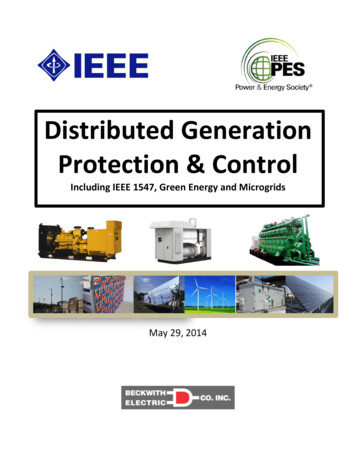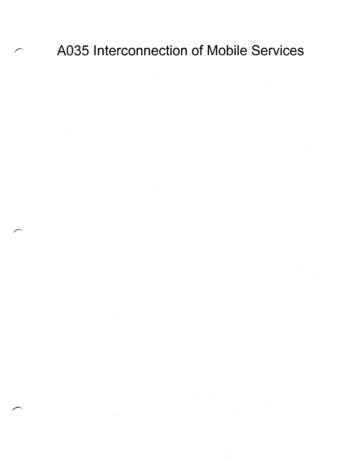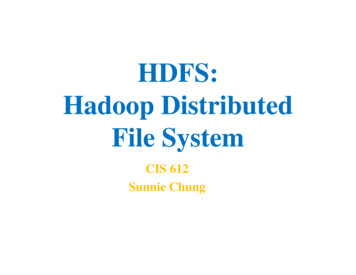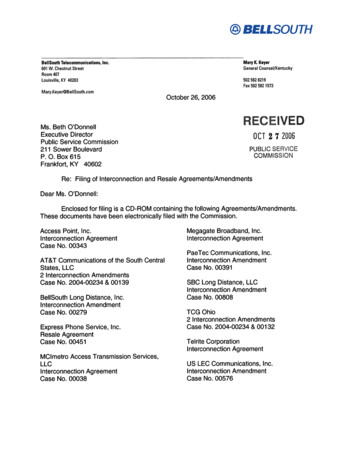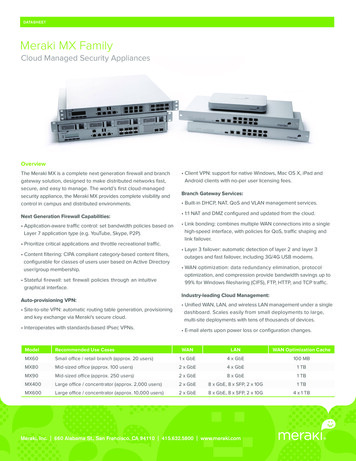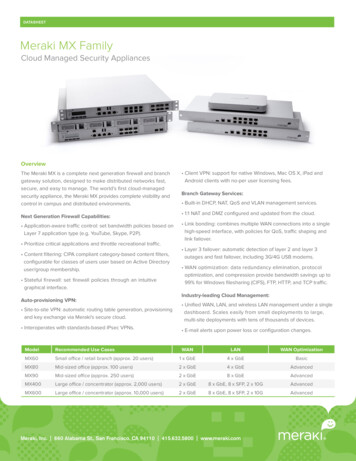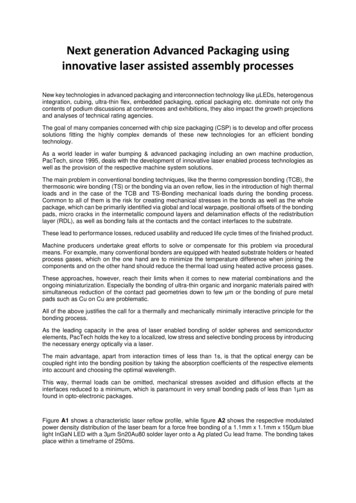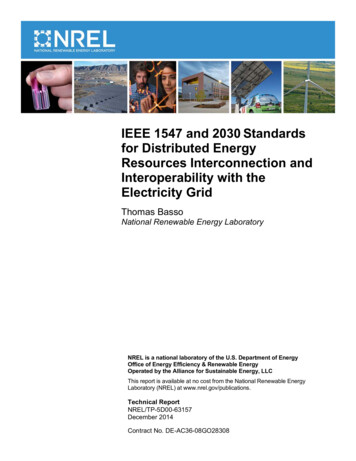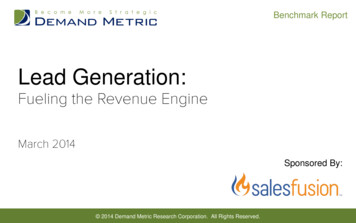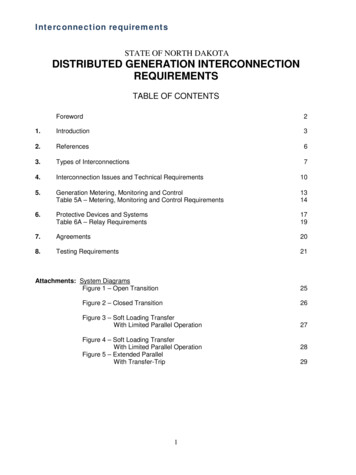
Transcription
Interconnection requirementsSTATE OF NORTH DAKOTADISTRIBUTED GENERATION INTERCONNECTIONREQUIREMENTSTABLE OF es of Interconnections74.Interconnection Issues and Technical Requirements105.Generation Metering, Monitoring and ControlTable 5A – Metering, Monitoring and Control Requirements13146.Protective Devices and SystemsTable 6A – Relay Requirements17197.Agreements208.Testing Requirements21Attachments: System DiagramsFigure 1 – Open Transition25Figure 2 – Closed Transition26Figure 3 – Soft Loading TransferWith Limited Parallel Operation27Figure 4 – Soft Loading TransferWith Limited Parallel OperationFigure 5 – Extended ParallelWith Transfer-Trip12829
Interconnection requirementsForewordElectric distribution system connected generation units span a wide range of sizes andelectrical characteristics. Electrical distribution system design varies widely from thatrequired to serve the rural customer to that needed to serve the large commercial customer.With so many variations possible, it becomes complex and difficult to create oneinterconnection standard that fits all generation interconnection situations.In establishing a generation interconnection standard there are three main issues that mustbe addressed; Safety, Economics and Reliability.The first and most important issue is safety; the safety of the general public and of theemployees working on the electrical systems. This standard establishes the technicalrequirements that must be met to ensure the safety of the general public and of theemployees working with Otter Tail Power. Typically designing the interconnection system forthe safety of the general public will also provide protection for the interconnected equipment.The second issue is economics; the interconnection design must be affordable to build. Theinterconnection standard must be developed so that only those items, that are necessary tomeet safety and reliability, are included in the requirements. This standard sets thebenchmark for the minimum required equipment. If it is not needed, it will not be required.The third issue is reliability; the generation system must be designed and interconnectedsuch that the reliability and the service quality for all customers of the electrical powersystems are not compromised. This applies to all electrical systems not just Otter TailPower.Many generation interconnection standards exist or are in draft form. The IEEE, FERC andmany states have been working on generation interconnection standards. There are otherstandards such as the National Electrical Code (NEC) that, establish requirements forelectrical installations. The NEC requirements are in addition to this standard. This standardis designed to document the requirements where the NEC has left the establishment of thestandard to “the authority having jurisdiction” or to cover issues which are not covered inother national standards.This standard covers installations, with an aggregated capacity of 10MW’s or less. Many ofthe requirements in this document do not apply to small, 100kW or less generationinstallations.2
Interconnection requirements1. IntroductionThis standard has been developed to document the technical requirements for theinterconnection between a Generation System and an area electrical power system “Utilitysystem or Area EPS”, here Otter Tail Power. This standard covers 3 phase Generation Systemswith an aggregate capacity of 10 MW’s or less and single phase Generation Systems with aaggregate capacity of 100kW or less at the Point of Common Coupling. This standard coversGeneration Systems that are interconnected with Otter Tail Power’s distribution facilities. Thisstandard does not cover Generation Systems that are directly interconnected with Otter TailPower’s Transmission System, Contact Otter Tail Power for their Transmission Systeminterconnection standards.While, this standard provides the technical requirements for interconnecting a GenerationSystem with a typical radial distribution system, it is important to note that there are some uniqueArea EPS, which have special interconnection needs. One example of a unique Area EPS wouldbe one operated as a “networked” system. This standard does not cover the additional specialrequirements of those systems. The Interconnection Customer must contact the Owner/operatorof Otter Tail Power with which the interconnection is intended, to make sure that the GenerationSystem is not proposed to be interconnected with a unique Area EPS. If the plannedinterconnection is with a unique Area EPS, the Interconnection Customer must obtain theadditional requirements for interconnecting with Otter Tail Power.Otter Tail Power has the right to limit the maximum size of any Generation System or number ofGeneration Systems that, may want to interconnect, if the Generation System would reduce thereliability to the other customers connected to Otter Tail Power.This standard only covers the technical requirements and does not cover the interconnectionprocess from the planning of a project through approval and construction. Please read thecompanion document “State of North Dakota Interconnection Process for Distributed GenerationSystems” for the description of the procedure to follow and a generic version of the forms tosubmit. It is important to also get copies of Otter Tail Power’s tariff’s concerning generationinterconnection which will include rates, costs and standard interconnection agreements. Theearlier the Interconnection Customer gets Otter Tail Power involved in the planning and designof the Generation System interconnection the smoother the process will go.3
Interconnection requirementsA)DefinitionsThe definitions defined in the “IEEE Standard for Interconnecting Distributed Resources withElectric Power Systems” (1547 Draft Ver. 11) apply to this document as well. The followingdefinitions are in addition to the ones defined in IEEE 1547, or are repeated from the IEEE1547 standard.i)“Area EPS” an electric power system (EPS) that serves Local EPS’s. Note. Typicallyan Area EPS has primary access to public rights-of-way, priority crossing of propertyboundaries, etc. Otter Tail Power’s distribution system is an AREA EPS.ii)“Generation” any device producing electrical energy, i.e., rotating generators driven bywind, steam turbines, internal combustion engines, hydraulic turbines, solar, fuel cells,etc.; or any other electric producing device, including energy storage technologies.iii) “Generation System” the interconnected Distributed Generation(s), controls, relays,switches, breakers, transformers, inverters and associated wiring and cables, up to thePoint of Common Coupling.iv) “Interconnection Customer” the party or parties who are responsible for meeting therequirements of this standard. This could be the Generation System applicant, installer,designer, owner or operator.v) “Local EPS” an electric power system (EPS) contained entirely within a single premisesor group of premises.vi) “Point of Common Coupling” the point where the Local EPS is connected to Otter TailPower.vii) “Transmission System”, are those facilities as defined by using the guidelinesestablished by Federal Energy Regulatory Commission.viii) “Type-Certified” Generation paralleling equipment that is listed by an OSHA listednational testing laboratory as having met the applicable type testing requirement of UL1741. At the time is document was prepared this was the only national standardavailable for certification of generation transfer switch equipment. This definition doesnot preclude other forms of type-certification if agreeable to Otter Tail Power.B) Interconnection Requirements GoalsThis standard defines the minimum technical requirements for the implementation of theelectrical interconnection between the Generation System and Otter Tail Power. It does notdefine the overall requirements for the Generation System. The requirements in thisstandard are intended to achieve the following:i) Ensure the safety of utility personnel and contractors working on the electrical powersystem.ii)Ensure the safety of utility customers and the general public.iii) Protect and minimize the possible damage to the electrical power system and othercustomer’s property.iv) Ensure proper operation to minimize adverse operating conditions on the electrical4
Interconnection requirementspower system.C) ProtectionThe Generation System and Point of Common Coupling shall be designed with properprotective devices to promptly and automatically disconnect the Generation from Otter TailPower in the event of a fault or other system abnormality. The type of protection required willbe determined by:i) Size and type of the generating equipment.ii) The method of connecting and disconnecting the Generation System from the electricalpower system.iii) The location of generating equipment on Otter Tail Power.D) Otter Tail Power ModificationsDepending upon the match between the Generation System, Otter Tail Power and how theGeneration System is operated, certain modifications and/or additions may be required to theexisting Otter Tail Power system with the addition of the Generation System. To the extentpossible, this standard describes the modifications which could be necessary to Otter TailPower for different types of Generation Systems. For some unique interconnections, additionaland/or different protective devices, system modifications and/or additions will be required byOtter Tail Power; In these cases Otter Tail Power will provide the final determination of therequired modifications and/or additions. If any special requirements are necessary they will beidentified by Otter Tail Power during the application review process.E)Generation System ProtectionThe Interconnection Customer is solely responsible for providing protection for the GenerationSystem. Protection systems required in this standard, are structured to protect Otter TailPower’s electrical power system and the public. The Generation System Protection is notprovided for in this standard. Additional protection equipment may be required to ensureproper operation for the Generation System. This is especially true while operatingdisconnected, from Otter Tail Power. Otter Tail Power does not assume responsibility forprotection of the Generation System equipment or of any portion Local EPS.F)Electrical Code ComplianceInterconnection Customer shall be responsible for complying with all applicable local,independent, state and federal codes such as building codes, National Electric Code (NEC),National Electrical Safety Code (NESC) and noise and emissions standards. As required byNorth Dakota State law, Otter Tail Power will require proof of complying with the NationalElectrical Code before the interconnection is made, through installation approval by anelectrical inspector recognized by the North Dakota State Board of Electricity.The Interconnection Customer’s Generation System and installation shall comply with latestrevisions of the ANSI/IEEE standards applicable to the installation, especially IEEE 1547;“Standard for Interconnecting Distributed Resources with Electric Power Systems”. See thereference section in this document for a partial list of the standards which apply to thegeneration installations covered by this standard.5
Interconnection requirements2.ReferencesThe following standards shall be used in conjunction with this standard. When the stated versionof the following standards is superseded by an approved revision then that revision shall apply.IEEE Std 100-2000, “IEEE Standard Dictionary of Electrical and Electronic Terms”IEEE Std 519-1992, “IEEE Recommended Practices and Requirements for Harmonic Control inElectric Power Systems”IEEE Std 929-2000,”IEEE Recommended Practice for Utility Interface of Photovoltaic (PV)Systems”.IEEE Std 1547, “IEEE Standard for Interconnecting Distributed Resources with Electric PowerSystems”IEEE Std C37.90.1-1989 (1995), “IEEE Standard Surge Withstand Capability (SEC) Tests forProtective Relays and Relay Systems”.IEEE Std C37.90.2 (1995), “IEEE Standard Withstand Capability of Relay Systems to RadiatedElectromagnetic Interference from Transceivers”.IEEE Std C62.41.2-2002, “IEEE Recommended Practice on Characterization of Surges in LowVoltage (1000V and Less) AC Power Circuits”IEEE Std C62.42-1992 (2002), “IEEE Recommended Practice on Surge Testing for EquipmentConnected to Low Voltage (1000V and less) AC Power Circuits”ANSI C84.1-1995,”Electric Power Systems and Equipment – Voltage Ratings (60 Hertz)”ANSI/IEEE 446-1995, “Recommended Practice for Emergency and Standby Power Systems forIndustrial and Commercial Applications”.ANSI/IEEE Standard 142-1991, “IEEE Recommended Practice for Grounding of Industrial anCommercial Power Systems – Green Book”,UL Std. 1741 “Inverters, Converters, and Controllers for use in Independent Power Systems”NEC – “National Electrical Code”, National Fire Protection Association (NFPA), NFPA-70-2002NESC – “National Electrical Safety code”. ANSI Cs-2000, Published by the Institute of Electricaland Electronics Engineers, Inc.6
Interconnection requirements3. Types of InterconnectionsA) The manner in which the Generation System is connected to and disconnected from Otter Tail Powercan vary. Most transfer systems normally operate using one of the following five methods oftransferring the load from Otter Tail Power to the Generation System.B) If a transfer system is installed which has a user accessible selection of several transfer modes, thetransfer mode that has the greatest protection requirements will establish the protection requirementsfor that transfer system.i) Open Transition (Break-Before-Make) Transfer Switch – With this transfer switch, the load to besupplied from the Distributed Generation is first disconnected from Otter Tail Power and thenconnected to the Generation. This transfer can be relatively quick, but voltage and frequencyexcursions are to be expected during transfer. Computer equipment and other sensitive equipmentwill shut down and reset. The transfer switch typically consists of a standard UL approved transferswitch with mechanical interlocks between the two source contactors that drop Otter Tail Powersource before the Distributed Generation is connected to supply the load.(1) To qualify as an Open Transition switch and the limited protective requirements, mechanicalinterlocks are required between the two source contacts. This is required to ensure that oneof the contacts is always open and the Generation System is never operated in parallel withOtter Tail Power. If the mechanical interlock is not present, the protection requirements areas if the switch is a closed transition switch.(2) As a practical point of application, this type of transfer switch is typically used for loads lessthan 500kW. This is due to possible voltage flicker problems created on Otter Tail Power,when the load is removed from or returned to Otter Tail Power source. Depending up OtterTail Power’s stiffness this level may be larger or smaller then the 500kW level.(3) Figure 1 at the end of this document provides a typical one-line of this type of installation.ii)Quick Open Transition (Break-Before-Make) Transfer Switch – The load to be supplied from theDistributed Generation is first disconnected from Otter Tail Power and then connected to theDistributed Generation, similar to the open transition. However, this transition is typically muchfaster (under 500 ms) than the conventional open transition transfer operation. Voltage andfrequency excursions will still occur, but some computer equipment and other sensitiveequipment will typically not be affected with a properly designed system. The transfer switchconsists of a standard UL approved transfer switch, with mechanical interlocks between the twosource contacts that drop Otter Tail Power source before the Distributed Generation is connectedto supply the load.(1) Mechanical interlocks are required between the two source contacts to ensure that one of thecontacts is always open. If the mechanical interlock is not present, the protectionrequirements are as if the switch is a closed transition switch.(2) As a practical point of application this type of transfer switch is typically used for loads lessthan 500kW. This is due to possible voltage flicker problems created on Otter Tail Power,when the load is removed from or returned to Otter Tail Power source. Depending up OtterTail Power’s stiffness this level may be larger or smaller than the 500kW level.(3) Figure 2 at the end of this document provides a typical one-line of this type of installation andshows the required protective elements.7
Interconnection requirementsiii) Closed Transition (Make-Before-Break) Transfer Switch – The Distributed Generation issynchronized with Otter Tail Power prior to the transfer occurring. The transfer switch thenparallels with Otter Tail Power for a short time (100 msec. or less) and then the GenerationSystem and load is disconnect from Otter Tail Power. This transfer is less disruptive than theQuick Open Transition because it allows the Distributed Generation a brief time to pick up theload before the support of Otter Tail Power is lost. With this type of transfer, the load is alwaysbeing supplied by Otter Tail Power or the Distributed Generation.(1) As a practical point of application this type of transfer switch is typically used for loads lessthen 500kW. This is due to possible voltage flicker problems created on Otter Tail Power,when the load is removed from or returned to Otter Tail Power source. Depending up OtterTail Power’s stiffness this level may be larger or smaller then the 500kW level.(2) Figure 2 at the end of this document provides a typical one-line of this type of installation andshows the required protective elements. The closed transition switch must include a separateparallel time limit relay, which is not part of the generation control PLC and trips thegeneration from the system for a failure of the transfer switch and/or the transfer switchcontrols.iv) Soft Loading Transfer Switch(1) With Limited Parallel Operation – The Distributed Generation is paralleled with Otter TailPower for a limited amount of time (generally less than 1-2 minutes) to gradually transfer theload from Otter Tail Power to the Generation System. This minimizes the voltage andfrequency problems, by softly loading and unloading the Generation System.(a) The maximum parallel operation shall be controlled, via a parallel timing limit relay(62PL). This parallel time limit relay shall be a separate relay and not part of thegeneration control PLC.(b) Protective Relaying is required as described in section 6.(c) Figure 3 at the end of this document provide typical one-line diagrams of this type ofinstallation and show the required protective elements.(2) With Extended Parallel Operation – The Generation System is paralleled with Otter TailPower in continuous operation. Special design, coordination and agreements are requiredbefore any extended parallel operation will be permitted. Otter Tail Power interconnectionstudy will identify the issues involved.(a) Any anticipated use in the extended parallel mode requires special agreements andspecial protection coordination.(b) Protective Relaying is required as described in section 6.(c) Figure 4 at the end of this document provides a typical one-line for this type ofinterconnection. It must be emphasized that this is a typical installations only and finalinstallations may vary from the examples shown due to transformer connections,breaker configuration, etc.v) Inverter ConnectionThis is a continuous parallel connection with the system. Small Generation Systems may utilizeinverters to interface to Otter Tail Power. Solar, wind and fuel cells are some examples ofGeneration which typically use inverters to connect to Otter Tail Power. The design of suchinverters shall either contain all necessary protection to prevent unintentional islanding, or theInterconnection Customer shall install conventional protection to affect the same protection. All8
Interconnection requirementsrequired protective elements for a soft-loading transfer switch apply to an inverter connection.Figure 5 at the end of this document, shows a typical inverter interconnection.(1) Inverter Certification – Prior to installation, the inverter shall be Type-Certified forinterconnection to the electrical power system. The certification will confirm its anti-islandingprotection and power quality related levels at the Point of Common Coupling. Also, utilitycompatibility, electric shock hazard and fire safety are approved through UL listing of themodel. Once this Type Certification is completed for that specific model, additional designreview of the inverter should not be necessary by Otter Tail Power.(2) For three-phase operation, the inverter control must also be able to detect and separate forthe loss of one phase. Larger inverters will still require custom protection settings, whichmust be calculated and designed to be compatible with the specific Area EPS (i.e. Otter TailPower) being interconnected with.(3) A visible disconnect is required for safely isolating the Distributed Generation whenconnecting with an inverter. The inverter shall not be used as a safety isolation device.(4) When banks of inverter systems are installed at one location, a design review by Otter TailPower must be performed to determine any additional protection systems, metering or otherneeds. The issues will be identified by Otter Tail Power during the interconnection studyprocess9
Interconnection requirements4. Interconnection Issues and Technical RequirementsA) General Requirements - The following requirements apply to all interconnected generatingequipment. Otter Tail Power shall be the source side and the customer’s system shall be the loadside in the following interconnection requirements.i)Visible Disconnect - A disconnecting device shall be installed to electrically isolate Otter TailPower from the Generation System. The only exception for the installation of a visible disconnectis if the generation is interconnected via a mechanically interlocked open transfer switch andinstalled per the NEC (702.6) “so as to prevent the inadvertent interconnection of normal andalternate sources of supply in any operation of the transfer equipment.”The visible disconnect shall provide a visible air gap between Interconnection Customer’sGeneration and Otter Tail Power in order to establish the safety isolation required for work onOtter Tail Power’s distribution system. This disconnecting device shall be readily accessible 24hours per day by Otter Tail Power field personnel and shall be capable of padlocking by OtterTail Power field personnel. The disconnecting device shall be lockable in the open position.The visible disconnect shall be a UL approved or National Electrical Manufacture’s Associationapproved, manual safety disconnect switch of adequate ampere capacity. The visible disconnectshall not open the neutral when the switch is open. A draw-out type circuit breaker can be usedas a visual open.The visible disconnect shall be labeled, as required by Otter Tail Power to inform Otter TailPower field personnel.ii)Energization of Equipment by Generation System – The Generation System shall not energize ade-energized Otter Tail Power’s distribution system. The Interconnection Customer shall installthe necessary padlocking (lockable) devices on equipment to prevent the energization of a deenergized electrical power system. Lock out relays shall automatically block the closing ofbreakers or transfer switches on to a de-energized Otter Tail Power’s distribution system.iii)Power Factor - The power factor of the Generation System and connected load shall be asfollows;(1) Inverter Based interconnections – shall operate at a power factor of no less then 90%.at theinverter terminals.(2) Limited Parallel Generation Systems, such as closed transfer or soft-loading transfersystems shall operate at a power factor of no less than 90%, during the period when theGeneration System is parallel with Otter Tail Power, as measured at the Point of CommonCoupling.(3) Extended Parallel Generation Systems shall be designed to be capable of operating between95% lagging and 95% leading. These Generation Systems shall normally operate near unitypower factor ( /-98%) or as mutually agreed between Otter Tail Power and theInterconnection Customer.iv) Grounding Issues(1) Grounding of sufficient size to handle the maximum available ground fault current shall bedesigned and installed to limit step and touch potentials to safe levels as set forth in “IEEEGuide for Safety in AC Substation Grounding”, ANSI/IEEE Standard 80.10
Interconnection requirements(2) It is the responsibility of the Interconnection Customer to provide the required grounding forthe Generation System. A good standard for this is the IEEE Std. 142-1991 “Grounding ofIndustrial and Commercial Power Systems”(3) All electrical equipment shall be grounded in accordance with local, state and federalelectrical and safety codes and applicable standardsv) Sales to Otter Tail Power or other parties – Transportation of energy on the Transmission systemis regulated by the area reliability council and FERC. Those contractual requirements are notincluded in this standard. Otter Tail Power will provide these additional contractual requirementsduring the interconnection approval process.B) For Inverter based, closed transfer and soft loading interconnections - The following additionalrequirements apply:i)Fault and Line Clearing - The Generation System shall be removed from Otter Tail Power for anyfaults, or outages occurring on the electrical circuit serving the Generation Systemii)Operating Limits in order to minimize objectionable and adverse operating conditions on theelectric service provided to other customers connected to Otter Tail Power, the GenerationSystem shall meet the Voltage, Frequency, Harmonic and Flicker operating criteria as defined inthe IEEE 1547 standard during periods when the Generation System is operated in parallel withOtter Tail Power.If the Generation System creates voltage changes greater than 4% on Otter Tail Power, it is theresponsibility of the Interconnection Customer to correct these voltage sag/swell problemscaused by the operation of the Generation System. If the operation of the interconnectedGeneration System causes flicker, which causes problems for others customer’s interconnectedto Otter Tail Power, the Interconnection Customer is responsible for correcting the problem.iii)Flicker - The operation of Generation System is not allowed to produce excessive flicker toadjacent customers. See the IEEE 1547 standard for a more complete discussion on thisrequirement.The stiffer Otter Tail Power, the larger a block load change that it will be able to handle. For anyof the transfer systems Otter Tail Power voltage shall not drop or rise greater than 4% when theload is added or removed from Otter Tail Power. It is important to note, that if anotherinterconnected customer complains about the voltage change caused by the Generation System,even if the voltage change is below the 4% level, it is the Interconnection Customer’sresponsibility to correct or pay for correcting the problem. Utility experience has shown thatcustomers have seldom objected to instantaneous voltage changes of less than 2% on Otter TailPower’s distribution system, so most Otter Tail Power operators use a 2% design criteriaiv) Interference - The Interconnection Customer shall disconnect the Distributed Generation fromOtter Tail Power if the Distributed Generation causes radio, television or electrical serviceinterference to other customers, via the EPS or interference with the operation of Otter TailPower’s distribution system. The Interconnection Customer shall either effect repairs to theGeneration System or reimburse Otter Tail Power Operator for the cost of any required Otter TailPower modifications due to the interference.11
Interconnection requirementsiv) Synchronization of Customer Generation(1) An automatic synchronizer with synch-check relaying is required for unattended automaticquick open transition, closed transition or soft loading transfer systems.(2) To prevent unnecessary voltage fluctuations on Otter Tail Power, it is required that thesynchronizing equipment be capable of closing the Distributed Generation into Otter TailPower within the limits defined in IEEE 1547 . Actual settings shall be determined by theRegistered Professional Engineer establishing the protective settings for the installation.(3) Unintended Islanding – Under certain conditions with extended parallel operation, it would bepossible for a part of Otter Tail Power to be disconnected from the rest of Otter Tail Powerand have the Generation System continue to operate and provide power to a portion of theisolated circuit. This condition is called “islanding”. It is not possible to successfully reconnectthe energized isolated circuit to the rest of Otter Tail Power since there are no synchronizingcontrols associated with all of the possible locations of disconnection. Therefore, it is arequirement that the Generation System be automatically disconnected from Otter TailPower immediately by protective relays for any condition that would cause Otter Tail Powerto be de-energized. The Generation System must either isolate with the customer’s load ortrip. The Generation System must also be blocked from closing back into Otter Tail Poweruntil Otter Tail Power is reenergized and Otter Tail Power voltage is within Range B of ANSIC84.1 Table 1 for a minimum of 1 minute. Depending upon the size of the GenerationSystem it may be necessary to install direct transfer trip equipment from Otter Tail Powersource(s) to remotely trip the generation interconnection to
ANSI/IEEE Standard 142-1991, “IEEE Recommended Practice for Grounding of Industrial an Commercial Power Systems – Green Book”, UL Std. 1741 “Inverters, Converters, and Controllers for use in Independent Power Systems” NEC – “National Electrical Code”, Na
